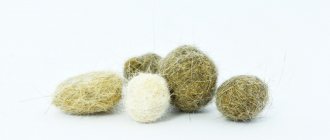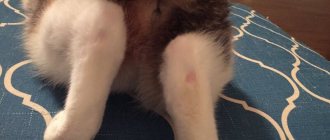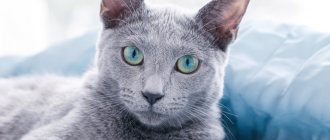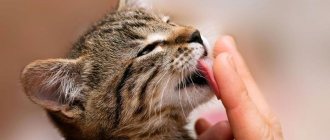What is flaking and how does it manifest itself in bald people?
Peeling is the formation of scales (squama), keratinized pieces of the epidermis. The separation of keratinized particles of the epidermis occurs constantly and is a normal physiological process, that is, the skin is renewed. With various skin diseases, this process intensifies. Scales can be separated either in very small (pityriasis-like) pieces or in plates. Depending on the underlying disease, the skin may be swollen, hyperpigmented, or, on the contrary, thin out and become almost transparent and reddish.
As we can see, flaking in Sphynx cats can be caused by a variety of factors, so it is necessary to make a diagnosis after a comprehensive examination of the cat. At home, if there are no other lesions on the skin besides peeling, you can try changing your skincare products and being more attentive to your cat’s hygiene. If there is no positive dynamics, try to make an appointment with a dermatologist. The doctors at our veterinary clinic will carefully examine your pet, perform a series of diagnostic tests to identify the cause of the flaking, and prescribe the optimal treatment.
Diagnosis of alopecia in different parts of the body
Only a doctor can determine why a cat is going bald. The basis of diagnosis includes medical history, visual examination, and microscopic examination of hair roots.
The pet's blood is examined and a scraping is taken from the skin. If a tumor is suspected, an x-ray or ultrasound is performed.
The diagnosis is partially helped by the localization of bald spots on a cat:
- Symmetrical baldness of the abdomen, thighs, sides, and front legs is a characteristic symptom of a skin disease.
- Due to stress, cats tear out hairs in the anus, on the back, paws, stomach, and inner thighs. This happens especially often in the following breeds: Siamese, Abyssinian, Himalayan.
- Hormonal disorders are usually indicated by alopecia on the bridge of the nose, base of the tail, hips, and chest. The skin ceases to be elastic.
- In the case of a lack of thyroid hormones, pet hair is easily pulled out in the pelvic area, on the stomach, chest and neck.
- Cancerous formations provoke bald spots on the stomach, chest, and paws. Oncology can cause complete hair loss.
- Vitamin deficiency is characterized by the appearance of small, round bald patches, which can unite. The skin in places where there is no fur is bright pink.
- Fungal infections are characterized by the appearance of bald spots with scaly, cracked skin.
Scratching a pet's skin is dangerous due to infection and the development of an inflammatory process.
To make it easier for you to determine the cause of your pet's baldness, we have prepared a table. It contains all the main pathologies accompanied by hair loss in a cat:
Minuses
But there are also unresolved issues in statin treatment. Thus, from 40 to 75% of patients stop taking statins within 1-2 years after starting treatment. Patients name the reasons for this: fear of developing undesirable effects from the instructions for the drug (46%), disbelief that the medicine prolongs life (29.4%), taking a large number of other pills (27.6%), forgetfulness (26.5 %), poor control of blood cholesterol levels while taking medication (18.8%), drug withdrawal by a non-attending physician (13.5%). At the same time, the actual development of undesirable effects on statin therapy was observed only in 11.7% of patients, and their manifestations were mild and moderate in severity.
Muscle symptoms
The incidence of symptoms of muscle damage is 7-29%, according to various sources. These include:
- muscle pain;
- muscle weakness;
- muscle inflammation, determined based on examination of a sample of muscle tissue and/or magnetic resonance imaging (MRI);
- myonecrosis - muscle damage, determined by a significant increase in serum creatine kinase (CK) levels;
- rhabdomyolysis - destruction of muscle tissue with acute kidney damage with an increase in serum creatinine;
- autoimmune myopathy is a rare complication accompanied by severe muscle damage even after discontinuation of the drug;
The reasons for this are not well understood. According to one version, there is a decrease in coenzyme Q10 in muscle tissue and a decrease in the level of vitamin D. The work of mitochondria is affected.
Muscle symptoms occur in 7-29%.
Symptoms usually appear in both arms or legs. The period of appearance is about 4-6 weeks after starting to take statins. Sometimes, with diseases of the joints and ligaments, pain increases. This may be due to muscle weakness. Unusually, physically active people are more likely to suffer from muscle symptoms. One study found that athletes were less tolerant of lipid-lowering therapy.
According to research, these symptoms are rare. But the studies themselves often exclude older patients, those with impaired liver and kidney function, and those taking certain medications, that is, it cannot be said that this is an ordinary elderly person with a “bouquet of diseases.”
Diabetes mellitus and insulin resistance
It has been established that long-term use of statins under certain factors can contribute to the development of insulin resistance and diabetes mellitus. This is evidenced not only by research data, but also by national recommendations of some countries.
Risk factors for developing diabetes when taking lipid-lowering drugs may include:
- high body mass index (BMI);
- elderly age;
- heart failure;
- myocardial infarction in the last six months and high cardiovascular risk;
- family predisposition to type 2 diabetes;
- Asian race;
- smoking, alcohol abuse.
Effects on the liver
When taking statins to reduce the negative effect on the liver, you must avoid taking:
- alcohol;
- drugs that are metabolized in the liver along the same pathways (for example, amiodarone, sulfonamides, methyldopa, cyclosporine).
Statins can negatively affect a damaged liver.
They should not be prescribed for active viral hepatitis until liver parameters return to normal.
Drug interactions
Statins have multiple effects. This is due to the fact that they do not act in isolation, but affect many chemical reactions in the body. This is especially important in patients taking multiple medications for cardiovascular diseases.
One area of the body is going bald
Baldness in the area of the hind legs most often occurs with liver lesions.
If only one area is balding and there are no visible reasons for this, you should urgently consult a doctor for a full comprehensive examination.
Possible factors causing alopecia:
- allergic reaction to medications, food, dangerous contacts;
- damaged hair follicles;
- injuries;
- stress;
- failure of endocrine processes;
- liver diseases;
- avitaminosis.
Avitaminosis
For normal functioning, the cat's body requires a complex of vitamins.
For normal functioning, the cat’s body, like the human body, requires the entire complex of vitamins and minerals, and the lack of them provokes various pathological processes. A lack of vitamins of a certain group is manifested by specific symptoms characteristic of this particular pathology.
Alopecia
A lack of B vitamins in the body can cause periodic vomiting in a cat.
- Along with the main symptom, there is a disorder of the digestive system in the form of periodic vomiting.
- Signs of dysfunction of the nervous and muscular systems appear.
- The animal is weak, lethargic, has an unsteady gait, and a sharp loss of weight.
- Global deficiency of vitamin B1 is expressed by paralysis and convulsions.
- Eliminated by eating more raw meat, bone meal, and yeast.
- Among other things, replenishment is required through the use of special vitamin preparations.
- Deficiency of vitamins B2 and B5 is manifested by cracks in the mucous membranes, slower growth of babies, decreased heart rate and body temperature.
- Eliminated by consuming dairy products and foods of plant origin.
- A lack of vitamin B12 manifests itself in more serious complications such as constipation, urination problems, enlarged liver and spleen, and intestinal colic.
Help only under the supervision of a veterinarian.
Cirrhosis of the liver
Liver cirrhosis in a cat.
As a result, a malfunction occurs, and subsequently a complete failure of all functions of the organ. There are several reasons for the appearance of this pathology.
Primary factors
Primary factors are most often caused by gradual intoxication of the body and, as a result, a large accumulation of toxins in the liver. Another reason that led to cirrhosis is hypovitaminosis of group B. With this pathology, symptoms appear after some time, as a result of the action of some aggressive factor. Provoking factors are also the failure of metabolic processes and hereditary predisposition.
Lack of food containing B vitamins can lead to cirrhosis of the liver.
Secondary factors
Infectious or invasive diseases and pathologies of the cardiovascular system act as secondary aggressors.
Infectious diseases can cause cirrhosis.
Signs
- For a long time, the only sign of cirrhosis may be the pet’s baldness in the abdomen and hind legs.
- Further, as the disease progresses, the abdomen becomes enlarged, which may indicate ascites.
- The cat looks tired, shows apathy and aggressive reactions to any attempts at contact.
- Decreased appetite, weight loss, and severe thirst.
- Frequent urination.
- In the final stages, convulsions, loss of coordination, and decreased vision are noted.
An enlarged abdomen may indicate ascites.
Treatment and therapy
Treatment is aimed at maintaining the heart and stopping the progression of the disease. If you refuse to eat, force-feeding is used using a drip infusion of glucose solution. Vitamin therapy and diuretics are prescribed.
If you refuse to eat, feeding with a drip solution is used.
Endocrine focal symmetric alopecia
Like most pathologies, it cannot arise independently and there are quite a lot of provoking factors: hypothyroidism, hyperfunction of the thyroid gland, hyperfunction of the adrenal cortex, diabetes. As a rule, symmetrical baldness is not accompanied by itching, although in the presence of allergic reactions such a phenomenon is quite possible, but in very rare cases.
As a rule, baldness is not accompanied by itching.
Treatment
Treatment depends on the identified pathology and is applied strictly under the supervision of a veterinarian. The owner’s only comprehensive help is timely contact with a specialist.
Treatment should be strictly under the supervision of a veterinarian.
The main manifestations of various causes of baldness
You can understand what causes a receding hairline by paying attention to a number of symptoms. They often allow you to find out, even without examination, the reason why hair is growing on your cat’s belly.
- Allergy - in addition to baldness, small abscesses and a reddish rash also appear on the skin. Coughing and sneezing may also sometimes be added.
- Parasites - it is not difficult to notice the presence of lice and fleas by simply examining your pet and unwrapping its fur.
- Abdominal injuries - if they are external, then the wounds will be visible to the eye. Internal bruises will not be visible; they are determined by the presence of anxiety and fearfulness of the cat. The animal may also react aggressively to touching its belly.
- Pancreatitis - symptoms of such a disorder in the functioning of the pancreas, in addition to baldness, are constant lethargy of the pet and regular diarrhea with blood.
- Endocrine disorders - symptoms depend on which endocrine organ is malfunctioning. Due to the variety of manifestations, it is impossible to make a diagnosis in such a situation on your own.
If your cat's belly is going bald, it is imperative that you consult a veterinarian to determine the cause and carry out proper treatment.
Where do bald spots come from?
Alopecia is pathological hair loss in a specific area of the body.
Some cats have normal alopecia. For example, in the area from the eyes to the ears, hair grows there less often and owners often turn to the veterinarian on the topic: “my cat’s forehead is bald.” Pathological alopecia is one of the symptoms of dermatitis - inflammation of the skin.
- Allergy
- Skin and intestinal parasites
- Stress
- Hormonal disorders
- Infectious and fungal diseases
- Lack of some vitamins
So dermatitis can be considered a serious reason to visit the veterinarian, but for now let’s look at the existing diseases in more detail.
Allergic dermatitis
In fact, cats have terrible allergies. An allergy may be to:
- Chicken
- Pork
- Cereal feed components
- Cleaning agent
- Filler
- Drugs
And much more.
The allergy is manifested by severe shedding, ulcerations on the skin, scratching and restlessness of the cat. A runny nose and lacrimation appear for the second time.
Cats with allergies are prescribed medicated food for life. The most popular are the food from the Royal Canin and Hills line.
Skin and intestinal parasites
Skin fleas include fleas. They bite the animal and cause discomfort, and the cat begins to itch intensely. The hair follicles are injured from such pressure, and the hair falls out, and scratches appear on the exposed skin.
Fleas do not live on the cat itself, but only on the litter. But dark spots of bites are visible on the pet’s body. Favorite places for fleas are the chin, base of the tail and lower abdomen.
In the presence of internal parasites, cats do not tend to tear off their skin, but their fur falls out intensively. Simply because there are not enough nutrients for hair.
Treatment involves treating the cat for parasites.
Stress
A cat experiences severe stress if:
- A small child appears in the house
- Other animals appear in the house
- Moving
- Long road
- Going to the vet
The fur flies off the animal's body quickly and rapidly, and if nervous tension continues for a long time, then bald areas appear on its body.
Treatment: eliminate the stress factor. If for some reason this is not possible, then the cat is prescribed sedatives or anti-stress food.
Hormonal disorders
Causes of hormonal imbalance:
- Change of seasons
- Estrus
- Taking hormonal medications, for example, during estrus or to stimulate it
- Disorders of the pancreas, thyroid glands and adrenal cortex
- Long-term use of non-steroidal anti-inflammatory drugs
Treatment consists of restoring hormonal levels, but before this the animal goes through a long journey of various diagnostic manipulations.
Fungal diseases
The most famous fungus is lichen. It is widespread, and you can only get sick when your immune system is severely weakened. It appears as bald spots on the face, with redness and peeling of the skin.
Diagnosed by pointing a Wood's lamp at the affected area.
It is treated by taking antifungal agents on the skin itself and internally.
Treatment of reactive pancreatitis in children
If symptoms of pancreatitis appear, you should immediately consult a doctor. Some forms of pancreatitis require intensive care in a hospital setting!
Diagnosis of the disease is carried out using a blood test (biochemistry) and ultrasound examination of the abdominal cavity. If the diagnosis is determined correctly, then the treatment of reactive pancreatitis in children has the same principles as the treatment of the acute form of the disease.
The treatment mechanism for reactive pancreatitis includes diet and complex drug therapy. These could be antibiotics, enzymes, antihistamines - the correct drug treatment regimen should be determined by a doctor.
An important condition for the treatment of reactive pancreatitis in children is diet. The principles of nutrition during illness include:
exclusion of all possible irritants from the children's diet in order to ensure functional unloading of the pancreas; introduction of steamed or boiled products - they are recommended to be taken warm and grated; maintaining the energy value of the diet - it is necessary to reduce the protein content in favor of fats and carbohydrates; small and frequent meals - three meals a day are contraindicated for reactive pancreatitis. Instead, you should adhere to a scheme of 5-6 meals a day at intervals of no more than 4 hours.
The doctor may recommend spending the first day of treatment on therapeutic fasting, which allows drinking only mineral water without gas. And the very next day you can introduce light chicken or rabbit broth, porridge, boiled chopped vegetables (excluding cabbage, legumes, radishes and radishes), low-fat cottage cheese, and omelet.
Drug treatment of reactive pancreatitis in children is aimed at:
- pain relief;
- maintaining digestion and ensuring food digestion;
- detoxification;
- if necessary, relieve allergy symptoms;
- increasing the body's resistance (vitamin therapy).
Find out more An important step in the treatment of reactive pancreatitis is the normalization of the digestive process1. For this purpose, the modern enzyme preparation Creon®2 is used. It replenishes the deficiency of pancreatic enzymes and promotes comfortable digestion of food. Due to its high safety profile, Creon® can be prescribed to children from birth2,3. More information about the use of Creon® in children can be found here. The main condition for the prevention of reactive pancreatitis is adherence to the principles of a healthy diet. Parents need to systematically but persistently change their child’s gastronomic tastes, understanding that what is tasty and dangerous is a possible step towards pancreatic pathology and chronic diseases.
The cat has lost hair on his belly
Recommended Posts
The cat's belly hair fell out, leaving only a short fluff. A “bald patch” has formed in the form of a triangle. The skin under the fluff is clean, pink, dense to the touch, there are two papillae on the sides. We noticed this about a month and a half ago, apparently he went bald at the end of summer.
The cat is 13 years old, no breed, neutered, not vaccinated, has not been ill with anything, active and cheerful, pees every day, poops once a week. We feed him all his life raw fish and meat, cucumbers, sometimes peas, etc., in the summer, grass from the street. Kitiket once a week. Doesn't go outside, only taken out a couple of times all summer.
“Yes, there is such an opinion among our brother. Not everything is so simple; very often even a good doctor underestimates diet therapy. In this matter I adhere to the opinion of BSAVA - the British Association of Small Animal Veterinary Medicine. This is, so to speak, a globally recognized brand of approach in global veterinary science.
Let me give you this example: So you give a cat a raw egg, a very healthy product, both proteins and fats and amino acids, but the egg contains avidin, which is killed by biotin, by the way, this can be the cause of baldness. Or you give your cat vitamin B1 and sea fish, such as cod, or just fish oil, which is healthy, but sea fish and fish oil contain the enzyme thiaminase, which simply breaks down vitamin B1. These substances are called antivitamins and are sometimes found in healthy foods. And the type of feeding that you use is called unbalanced feeding. In addition to antivitamins, many minerals compete with each other in the body, for example calcium with phosphorus, etc. The result of their mutual competition is a violation of bone mineralization in kittens, the so-called juvenile osteopenia of kittens.
Well, in the end, you must agree that those who advocate for straight women do not take into account that porridge and the whole list of that horror
Source
What causes a cat to go bald, what happens to it
Cats go bald for various reasons.
These include:
pregnancy or stress. During pregnancy, lactation, or due to severe stress, a cat may begin to lose fur. But there is no need for treatment; after a while it will grow again;
- baldness above the eyes. At the age of 14 to 20 months, cats, especially dark shorthaired cats, begin to lose hair above their eyes. This process is natural and, if there is no redness, treatment is also not required;
- side effect of the medicine. Sometimes baldness occurs after taking medications;
- consequences of the injection. Sometimes baldness occurs in the area where the injection was given after a couple of months. In addition, there may be skin thickening and hyperpigmentation. Everything also goes away on its own;
- fleas. There are varieties of fleas that cause baldness.
- ringworm. Signs (in addition to hair loss): peeling of the skin, the appearance of crusts, and sometimes itching;
- allergy/contact dermatitis. It happens that a cat develops an allergy from antibiotics or some food component, as well as from interaction with certain materials, metals, and chemicals. In addition to hair loss, redness, bumps, and itching occur;
- solar dermatosis. This reaction to sunlight usually occurs in white cats. It goes away on its own (although the animal will need to avoid sunlight), but sometimes medications are also necessary. Symptoms: hair falls out, redness occurs, crusts and sores appear on the nose and ears;
cheyletiellosis. The causative agent is a tick. The cat itches a lot, but if the disease has not worsened significantly, hair loss is usually minimal;
Important! Ticks easily climb onto other animals and even people.
folliculitis. Infectious disease of hair follicles, occurring on the face, neck, head, accompanied by itching, hair loss;
hyperthyroidism. It happens due to increased secretion of thyroid hormones. With this disease, the fur is easily pulled out and falls out profusely, the cat itches and licks a lot, which causes irritation on the skin;
neurogenic dermatitis. Due to stress, anxiety, or boredom, a cat may lick itself a lot. As a rule, fur loss is symmetrical. To heal, you need to understand the cause of the stressful condition;
alopecia areata. An autoimmune disease that goes away on its own. Fur falls out on the head, neck, body (without itching).
- seborrhea. It can be congenital or acquired (after feline leukemia virus, infectious peritonitis, feline immunodeficiency virus, ringworm, parasites). It manifests itself in different ways: scales appear on the skin, the fur becomes very dry/oily, an unpleasant odor occurs, hair loss occurs;
- hyperadrenocorticism. Caused by elevated levels of corticosteroids (occurs not only for natural reasons, but also as a result of prolonged hormonal treatment). Signs: baldness, thinning of the skin, hyperpigmentation, comedones, bruises;
demodicosis (glandular acne). A tick-borne infection that affects the face and neck. If demodicosis is generalized, this indicates immunodeficiency. Symptoms: baldness, the appearance of scales, redness, itching;
polymorphic erythema. It appears due to increased sensitivity to a medication or infection, and may be one of the manifestations of oncology or other diseases. There is loss of fur, blisters (near the mouth, ears, groin, armpits), and sometimes ulcers. Sometimes the temperature rises and apathy appears.
Important! There are many causes of baldness and medications are not always necessary. But still, do not self-treat; be sure to take your pet to a veterinarian for an accurate diagnosis.
Prevention measures
To protect your family pet from skin diseases that are accompanied by baldness, it is necessary to provide proper care for the cat:
- The first and most important thing is preventive examinations. You can do them yourself. While bathing, brushing, and playing with your cat, it is very convenient to check the condition of its coat. Regular monitoring will ensure that you do not miss the appearance of alarming symptoms.
- Timely vaccinations against infectious diseases will improve your pet's health.
- Regular (once every 4-5 months) antiparasitic treatment is a shield against skin diseases.
- Deworming medications are required for all cats.
- A calm and friendly atmosphere in the family without stress and scandals is useful not only for people, but also for cats.
- If the cat is about to move, change owners, or the house is about to be renovated, a good solution would be to use sedatives.
- You should not allow contact with unfamiliar animals - they can be carriers of the causative agent of alopecia.
- A balanced diet and proper nutrition are the key to a healthy cat.
To preserve not only the health, but also the beauty of your pet, it is important to be an attentive and sensitive owner. Timely adoption of measures will eliminate the disease at the very beginning - and this will relieve stress from both the cat and the owner.
And it is important to always remember that self-medication can seriously aggravate the course of the disease.
I like2I don't like
Symptoms
In addition to the main symptom of alopecia, that is, hair loss, a cat may exhibit accompanying symptoms. Its features depend on the main provocateur. The table lists the diseases and their associated symptoms.
Table 1. Diseases accompanied by alopecia in cats
| Image | Symptoms |
| Scabies, fungal infection | Redness, itching, peeling. Later, papules, pus or sores appear. Hair can fall out not only all over the body, but also only in the head area (near the eyes, on the ears, etc.) |
| Avitaminosis | Small bald round patches with pink skin |
| Malignant tumor | First, the hair on the stomach falls out, the skin becomes shiny. Later, alopecia spreads to the chest, neck and paws |
| Lack of thyroid hormones or pancreatitis | The tail, back, pelvic area and hind legs become bald. Bald spots heal very slowly |
| Dermatological diseases and behavioral disorders | Hair falls out all over the body, there are no separate lesions |
| Stress | The cat breaks and pulls out hairs at the anus, on the tail, belly, paws |











